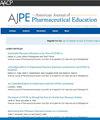Impact of a Modular Bridge Course for First-Year Pharmacy Students
IF 3.8
4区 教育学
Q1 EDUCATION, SCIENTIFIC DISCIPLINES
引用次数: 0
Abstract
Objective
To determine the short-term impact of redesigning first professional year (first-year pharmacy [P1]) content using cognitive load theory on academic success and student well-being.
Methods
This retrospective study compared outcomes from the P1 fall/spring semesters and academic year for the classes of 2026 (n = 99) and 2027 (n = 104) after a content redesign implemented in fall 2023. Student demographics, nonacademic factors (perceived stress, impostor syndrome, testing anxiety, Grit), and academic factors (grade point averages, progression rates, grades, remediations) were collected and analyzed. Data comparisons between cohorts utilized the Mann-Whitney test for continuous variables, χ2 test for categorical variables, and risk estimates for dichotomous variables.
Results
Academic outcomes showed no significant differences between cohorts. First-generation and non-White students in the class of 2026 were 3 times and 4.8 times more likely, respectively, to receive one or more grades below C- in the P1 year. Following curricular redesign, first-generation and non-White students in the class of 2027 did not exhibit increased likelihood of earning grades below C-. Non-White students in the class of 2027 no longer faced increased risk of not progressing to the P2 year, a significant improvement from the class of 2026, which showed a 6.9-fold increased risk. Additionally, remediating content during the P1 fall semester correlated with higher academic risk.
Conclusion
Curricular redesign utilizing cognitive load theory achieved comparable academic performance in P1 students overall, with notable benefits for first-generation and non-White students. This approach effectively identified students at risk, facilitating targeted and timely interventions.
模块化桥梁课程对药学一年级学生的影响。
目的确定使用认知负荷理论(CLT)重新设计第一个专业学年(P1)内容对P1学年学业成功和学生福祉的短期影响:这项回顾性研究比较了 2023 年秋季学期内容重新设计后,2026 级(人数=99)和 2027 级(人数=104)学生在 P1 秋季/春季学期和学年的学习成果。研究收集了学生的人口统计学特征、非学术因素(感知压力、冒名顶替综合征、考试焦虑、勇气)和学术因素(平均学分绩点、升学率、成绩、补习)。对组内和组间的数据进行了比较:连续变量采用曼-惠特尼检验,分类变量采用卡方检验,二分类变量采用风险估计值:结果:各组学生在学习因素方面没有差异。2026 届学生中的第一代学生和非白人学生获得一个或多个等级结论的可能性分别高出三倍和 4.8 倍:在课程重新设计中应用文化教学法,小一学生的学业成绩相似,对第一代学生和非白人学生有益。它能识别出学业和升学情况较差的学生,以便进行有目的、有针对性的早期干预。
本文章由计算机程序翻译,如有差异,请以英文原文为准。
求助全文
约1分钟内获得全文
求助全文
来源期刊
CiteScore
4.30
自引率
15.20%
发文量
114
期刊介绍:
The Journal accepts unsolicited manuscripts that have not been published and are not under consideration for publication elsewhere. The Journal only considers material related to pharmaceutical education for publication. Authors must prepare manuscripts to conform to the Journal style (Author Instructions). All manuscripts are subject to peer review and approval by the editor prior to acceptance for publication. Reviewers are assigned by the editor with the advice of the editorial board as needed. Manuscripts are submitted and processed online (Submit a Manuscript) using Editorial Manager, an online manuscript tracking system that facilitates communication between the editorial office, editor, associate editors, reviewers, and authors.
After a manuscript is accepted, it is scheduled for publication in an upcoming issue of the Journal. All manuscripts are formatted and copyedited, and returned to the author for review and approval of the changes. Approximately 2 weeks prior to publication, the author receives an electronic proof of the article for final review and approval. Authors are not assessed page charges for publication.

 求助内容:
求助内容: 应助结果提醒方式:
应助结果提醒方式:


